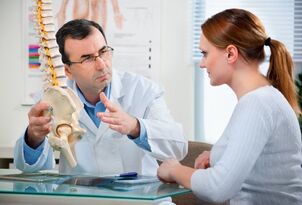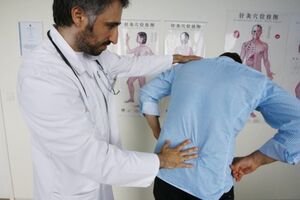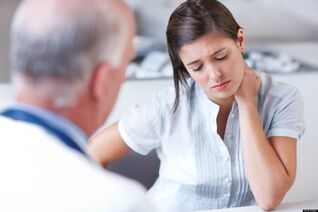
Everyone at least once in their life has a problem when their back hurts in the lumbar region. These symptoms often appear after sitting for a long time in an uncomfortable position. The pain is safe for health and disappears after resting well.
Treatment can be prescribed only after a complete diagnosis and determination of the cause and nature of the disease. No action can be taken on your own without a doctor's examination.
Various reasons
The most common causes of pain are: osteochondrosis, scoliosis, herniated discs. Tumor and tissue infections are more rare.
Pain manifests itself in different ways depending on the disease. If the cause of the pain is kidney colic or stomach ulcer, then the sensation persists regardless of the type of activity (a person is lying down or doing vigorous activity).
If there is osteochondrosis of the thoracic area, then the pain radiates to the heart, then the patient mistakenly believes that he is suffering from angina pectoris.
If the lower back hurts while lying down
When pain arises and a person does not know what to do with it, he prefers to lie down, hoping that the discomfort will disappear. But if the pain gets worse while lying down, there is a high possibility of a disease of the musculoskeletal system, called ankylosing spondylitis.
The disease strikes young men, changes occur in the vertebrae and it grows together, while the flexibility of the spine decreases.
Because the spine cannot take its natural position, a person feels pain while lying down.
Ankylosing spondylitis is inherited; chronic infectious diseases give impetus to its development. The pain increases if you lead an unstable lifestyle.
The first sign is a feeling of cramps in the spine, and if lying down the back pain gets worse. Early diagnosis can completely cure the disease.
Primary pain syndrome

Doctors distinguish between primary and secondary pain syndromes during back and back pain.
Primary low back pain syndrome involves morphofunctional musculoskeletal changes.
This is the most common cause of pain:
- osteochondrosis (damage to bone and cartilage tissue, intervertebral discs);
- spondyloptrosis (damage to the intervertebral joints that affects spinal movements).
Secondary pain syndrome
Secondary syndrome covers a variety of conditions that cause back pain in the lumbar region:
- scoliosis (curvature of the spine);
- reflected pain;
- osteoporosis and osteomalacia (bone tissue damage);
- ankylosing spondylitis (non-infectious inflammation);
- rheumatoid arthritis;
- isolated tumors or metastases form;
- tuberculosis, epidural abscess, brucellosis (infectious disease);
- stroke, which causes cerebrospinal circulatory disorders;
- gastrointestinal diseases (especially appendicitis);
- diseases of the pelvic area (renal colic, venereal disease);
- spinal cord fractures (the most dangerous and serious cause).
Acute pain
Low back pain is also classified as acute and chronic. Each shows a separate reason.
The most common but painful manifestation of acute pain is muscle spasm. It occurs due to the formation of cramps in the long muscles.
Athletes and people with work expertise suffer the most. The pain is localized in the lower back, but is felt clearly in other parts of the body, while a person’s movement is limited, and the pain disappears.

Spinal injuries also cause acute pain. The most dangerous injury is a fracture of the spine.
Fractures can be caused by a fall, or they can occur completely unnoticed, for example, if the person has Paget's disease, osteoporosis, hyperparathyroidism, or has a tumor.
Transplantation of the intervertebral disc in the lumbar region also causes pain. In this case, one's movement will be very limited.
The pain itself is caused by compression of the nerve root. Additional symptoms:
- sensitivity violations;
- decreased or complete absence of Achilles and knee reflection;
- radicular pain.
Vertebral transplantation can cause pathology nearby, which is healthy until the last one. Disorders of the lower vertebrae cause diseases of the bladder and intestines.
Another reason for acute pain is facet syndrome. In this case, the intervertebral disc is not affected, only root compression, which comes out of the spinal canal, occurs. The intervertebral foramen narrows due to narrowing of the intervertebral foramen.
Serious illnesses such as epidural abscesses can also cause pain. What to do in this case?
Illness should not be delayed, as it can lead to tragic consequences. It is necessary to immediately perform all measures to relieve spinal pressure, sometimes surgical intervention is required.
In the area from the lower back to the knees, pain caused by hip joint disease can be given.
Chronic pain
If the back pain in the lumbar region and the pain is always there, pain or pulling naturally, this indicates a disease other than acute pain.

The first cause is spondylosis deformans. The lumbar spine vertebra undergoes dystrophy changes, weakened ligaments, and bone growth begins.
As a result, bone growth begins to put pressure on the nerve roots and pain occurs. Numbness and weakness in the legs can add to the symptoms.
Chronic back pain can be caused by cancer or metabolic disorders.
In this case, you need to do anticancer therapy, change your regimen and daily diet to eliminate the cause, everything else will not be effective.
Another cause is osteomyelitis, when the infection enters the bone and causes inflammation.
Diseases that cause lower back pain
Other conditions that cause lumbar pain
- arthropathy aspect;
- spinal stenosis;
- disc herniation;
- myogenic pain;
- ruptured annulus fibrosus.
In women, pain can be triggered by pelvic diseases, such as endometriosis, uterine and ovarian carcinomas. In men - prostatitis or prostate carcinoma.

Sick kidneys, tumors in the abdomen, duodenum can also be given to the lumbar region. Pain occurs with ulcerative colitis, colon tumors, diverticulitis.
If the pain extends not only to the lumbar, but also to the thoracic region, then it is important to exclude the possibility of aortic dissection.
Non-hazardous causes can be physiological changes, for example, the postpartum period or sudden weight gain, the effects of epidural anesthesia.
Such pain treatment is not carried out, the patient can do nothing, the pain will go away on its own after some time.
Lumbar Spine Treatment
Before starting treatment, you need to make a correct diagnosis. First, the doctor performs a clinical examination of the patient, then depends on the results of the ultrasound and MRI examination.
Based on the diagnosis, a treatment program has been selected, combining various methods.
First of all, treatment aims to relieve pain to return the patient to a comfortable life. However, complete cure of the disease (if possible) can last for years.
If the bruise is the cause of the disease, then the traumatologist will carry out his treatment. Depending on the cause of the pain, which should be identified by a therapist / family doctor, an orthopedist, nephrologist, urologist, proctologist, gynecologist, cardiologist, gastroenterologist, pulmonologist, infectious disease specialist can maintain further medical history.
Previously, back pain was treated exclusively with antibiotics. Now there are so many methods for treatment that only an experienced doctor will help you choose the right one.
To alleviate the patient's condition, it is recommended to change the mattress to an orthopedic one. The pain will be relieved with anesthetic heating ointment and gel, which also contains anti-inflammatory components.
The use of non-steroidal anti-inflammatory drugs is also recommended. Muscle cramps will relieve muscle relaxation, nerve root edema will eliminate diuretic and vascular medications.
When the patient is able to return to normal life, treatment is continued with physiotherapy, massage and therapy exercises.
Treatment is carried out using the following non-drug methods:
- vacuum therapy;
- acupuncture;
- laser therapy;
- manual therapy;
- dry attraction;
- pharmacopuncture;
- electrical stimulation;
- magnetopuncture.
This treatment gives pain quickly and also eliminates the cause itself, thus ensuring long-term results.




























